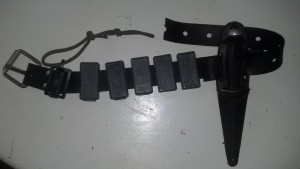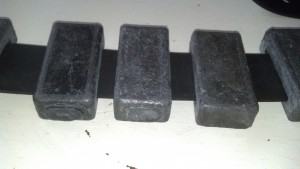Weight Belt
by David Hochman
The free divers weight belt may be the most important piece of equipment we have, yet the most over looked. Having a weight belt that is not fit right, layout properly, or designed well is no different than, well, having a undisciplined dog. Its like 12 years of constant pain. Having said that, lets take a close look at the free divers weight belt and its important part in our line up of free diving paraphernalia. Let me first stress, as important as it may be, never become attached to your weight belt. Like your speargun it should be considered an expendable item. That’s correct, an expendable item!! Hesitating during a bad situation underwater can be the difference between life and death. If you think you should drop your belt, never hesitate. It is a good idea to bring along a spare in case you have to drop one.
For free diver’s weight belts made from rubber are king. Why rubber and not nylon webbing? Do you remember the last time you where tank diving? As you dropped into deeper depths your nylon belt started doing loops around your waist like a hula-hoop. Your stomach compresses as you get to deeper depths. As your stomach compresses the belt becomes loose on your waist and begins shifting. While a tank diver is breathing air, this action is not a problem. They simply reach down, adjust the belt and the excess energy used is not a concern. The free diver is in a state of apnea, the task of adjusting the belt requires far too much energy. Energy requires oxygen, and the stress of the act, elevates the heart rate. Both of these reactions increased oxygen consumption and oxygen is our life line. This simple act increases the free divers chance of blackout. The rubber belt on the other hand compresses with the stomach staying fit and snug at all depths without shifting. We can now see the necessity of a rubber belt to the free diver.
The gold standard for free diving is the Marseille belt. It is of simple design, with a quick release buckle. A good one will last for many years. Like all rubber products store them in a dark cool place out of the sun or the life expediency of the belt will be decreased dramatically. These belts can be found on the internet by simply doing a search under, “Marseille weight belt for sale”.
For divers with a back problem cut a piece of rubber ¼ “x 6” x 1’ (or the width of the back of your waist) and attach it to your weight belt. We used to use old conveyor belts. Cut a slot (the width of the weight belt) 2” from each end in the center of the 6” width and thread the belt through it. This will allow the weights to sit on the rubber brace distributing the weight across your back giving you support.
The main weight belt question I am asked is ” how much weight do I need”? The most important thing to consider when getting your ideal belt weight is to be weighted buoyant at 15 feet. We do this for safety. Most black outs occur at approximately 10 feet from the surface. If we are buoyant at 15 feet, and blackout occurs, we will float to the surface allowing our dive partner to help. The consequence of not being buoyant at 15 feet is obvious and can lead to catastrophe. To figure out your proper weight there is a useful formula to start with.
When diving in a salt water environment, you will require weights of about eight percent of your body’s to achieve neutral buoyancy at 15 feet. Start with that formula. Test your buoyancy in small weight increments. It is safer to achieve neutral buoyancy at a shallower depth and add weight on your second test than sink too quickly and struggle to return to the surface. Add one to two pounds at a time when testing for neutral buoyancy. Add or subtract weight until you reach a neutral buoyancy of 15 feet. The weights required depend almost entirely on the buoyancy of the suit. As a corollary to this practice, free divers will use as thin a wet suit as comfortably possible, to minimize buoyancy changes with depth due to wet suit compression.You will require some trial and error so be sure to do this with a good partner. Remember that in fresh water you will need 3 % less weight.
Rigging a weight belt with fish stringers, clips to hold things and other attachments is a very personal thing. I will go into that in a future article. Just make sure nothing gets in the way of doing a quick release or “dump” of your belt. If you choose to put your dive knife on your belt as I do, be sure to secure it in a place that can be reached with either hand.
Last thing is the weights themselves. Multiple small streamline weights (1 to 2 lbs) are better than a few big weights. The weight will distribute better on your waist and small adjustments in buoyancy can be made. Good free diving weights are hard to find. I have seen them on different internet sites for sale, but the sellers come and go. I had a mold made years ago so I can make my own weight. I believe the weight design I use where originally designed by diver Bill Ernst. Below is a photo of them. If you can’t find a similar weight, the standard two pound dive weights sold in dive shops will work fine for you.
Seems simple, correct? It really is. It is important to stick to these simple rules. You will dive better and safer when you do.



